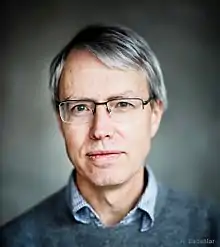John McCaskill
John S. McCaskill (born 1957) is an Australian chemist who works in a wide variety of fields ranging from theoretical biochemistry to novel computation to artificial life.

Biography
After graduating from Sydney University in 1978 (R. G. Gilbert advisor) and obtaining his PhD (D. Phil.) in 1982 as a Rhodes Scholar at New College, Oxford, McCaskill joined the group of Nobel prize-winner Manfred Eigen at the Max Planck Institute for Biophysical Chemistry in Göttingen, Germany. He became Professor for Theoretical Biochemistry at the Friedrich Schiller University Jena in 1992, founding a multidisciplinary research group in Biomolecular Information Processing (BioMIP) at the Institute for Molecular Biotechnology (imb Jena), a field which he pioneered for 25 years while holding positions at the GMD (National Research Center for Information Technology), the Fraunhofer Society, Ruhr University Bochum, the Santa Fe Institute, and the European Center for Living Technology at the Ca' Foscari University of Venice.[1]
Research
McCaskill is best known for his work on information processing in evolving and self-organizing molecular systems, spanning theoretical and experimental approaches that include novel devices and systems. His early work on molecular evolution was theoretical, using non-equilibrium statistical mechanics to solve Eigen’s equations of molecular quasispecies for realistic fitness landscapes[2] .[3] He developed an ensemble approach to RNA structure prediction, now in wide use,[4] and made several contributions, both theoretical and experimental, to the study of spatially-resolved molecular evolution, including the experimental implementation of spatially-resolved capillary and microfluidic flow reactors [5] [6] and also including the construction of NGEN and MEREGEN, large-scale reconfigurable systolic computers for simulating spatial evolution based on reprogrammmable FPGA hardware[7]
Since 2000, he has established a chemical microprocessor technology for electronically programmable matter via microscale electrochemistry, and applied it to the development of novel approaches towards artificial cells and DNA/RNA processing systems, including in vitro DNA/RNA processing systems, including Qß RNA, 3SR, SDA, 3SR-Predator-Prey ,[8] CATCH [9] and optical DNA Computing systems based on magnetic beads in microfluidic reactors [10] McCaskill led an international initiative to investigate evolvable artificial chemical cells with an EU-funded project, PACE, one of the earliest projects to explore a bottom-up approach to create an artificial living cell [11] [12] [13] .[14] Most recently his research has led to the development of novel autonomous and programmable electronic-chemical systems, leading other EU-funded projects, ECCell and MICREAgents, and opening a wide range of potential applications in basic and applied research.
McCaskill's current work includes modeling the essential interplay of self-organization and evolution in life-like chemical systems, and exploring the potential of electronic-chemical hybrid Information Technology based on these properties. He has produced over 100 scientific publications, taught courses and supervised PhD theses in disciplines ranging from chemistry, physics and biology to computer science, and his multidisciplinary work straddling theory and experiment has been recognized in invited lectures at international conferences around the world. He was an inaugural director of the European Center for Living Technology, and has since served on its science board. While McCaskill's main work is in basic science, it has helped spawn several start-up companies and continues to involve the coordination of major collaborative projects fostering novel links between science and industry.
References
- John, McCaskill. "McCaskill CV" (PDF). biomip.org. Retrieved 7 August 2019.
- McCaskill, J. S. (1984). "A localization threshold for macromolecular quasispecies from continuously distributed replication rates". The Journal of Chemical Physics. 80 (10): 5194–5202. doi:10.1063/1.446590.
- Eigen, Manfred, McCaskill, John, and Schuster, Peter. "The molecular quasi-species." Adv. Chem. Phys 75 (1989): 149-263, 1988. doi:10.1002/9780470141243.ch4
- McCaskill, John (1990). "The equilibrium partition function and base pair binding probabilities for RNA secondary structure". Biopolymers. 29 (6–7): 1105–1119. doi:10.1002/bip.360290621. hdl:11858/00-001M-0000-0013-0DE3-9.
- McCaskill, J.S.; Bauer, G.J. (1993). "Images of evolution: origin of spontaneous RNA replication waves". Proc. Natl. Acad. Sci. USA. 90 (9): 4191–4195. doi:10.1073/pnas.90.9.4191. PMC 46472. PMID 7683426.
- McCaskill, John (1997). "Spatially resolved in vitro molecular ecology". Biophysical Chemistry. 66 (2–3): 145–158. doi:10.1016/s0301-4622(97)00073-2. PMID 9362557.
- Tangen, U., Maeke, Th and McCaskill, J.S. "Advanced simulation in the configurable massively parallel hardware MereGen." Coupling of Biological and Electronic Systems. Springer, Berlin, Heidelberg, 2002. 107-118.
- Wlotzka, Britta; McCaskill, John (1996). "A molecular predator and its prey: coupled isothermal amplification of nucleic acids" (PDF). Chemistry and Biology. 4 (25–33): 25–33. doi:10.1016/s1074-5521(97)90234-9. Retrieved 13 August 2019.
- Ellinger, Thomas; Ehricht, Ralf; McCaskill, John (1998). "In vitro evolution of molecular cooperation in CATCH, a cooperatively coupled amplification system". Cell Chemical Biology. 5 (12): 729–241. doi:10.1016/s1074-5521(98)90665-2. Retrieved 13 August 2019.
- McCaskill, John (2001). "Optically programming DNA computing in microflow reactors". Bio Systems. 59 (2): 125–138. doi:10.1016/s0303-2647(01)00099-5. PMID 11267740.
- "Holy Grail of Artificial Life". The Irish Times. 2 September 2004.
- "The God-Machine. Is life to be created anew? (Die Gottes-Maschine. Ist das Leben ganz neu zu erfinden?)". GEO. August 2009.
- Lütke-Wissing, Stefan. "Die geheimen Baupläne der Natur". TIB Leibniz-Informationszentrum. Retrieved 13 August 2019.
- Regis, Ed (2008). What is Life?. New York: Farrar, Strauss and Giroux. pp. 140–141. ISBN 978-0-374-28851-8.
External links
- PACE (Programmable Artificial Cell Evolution)
- ECCell (Electronic Chemical Cell)
- MICREAgents (Microscale Chemically Reactive Agents)
- J. McCaskill BioMIP page.